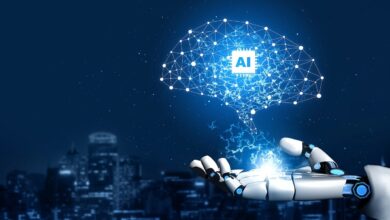The difference between symbolic artificial intelligence (AI) and The neural artificial intelligence

Artificial intelligence (AI) aims to create an autonomous machine capable of human-like thinking.
The main characteristic of AI is mimicking human cognitive function, particularly learning and problem-solving.
Top managers need to implement an entrepreneurial and innovative mindset and start using AI in their companies to remain competitive and viable.
Companies are more and more using AI, because they gain a competitive advantage. Using Ai is a business model innovation.
Business model is an activity system or a set of interdependent activities spanning firm boundaries.
Many global Companies such as Amazon, Uber, Tesla, Google, Alibaba and UPS, along with many others use an innovative business models and use AI to gain a competitive advantage.
The important data available today and the increase of data processing as well the improvements of computational power and algorithms have generated numerous applications of AI across many diverse industries.
The symbolic AI
It assumes that high-level representation of knowledge (symbol) and combinations of symbols can achieve human-like AI by performing reasoning in a manner similar to how humans express their thoughts and draw conclusions from deductive reasoning.
The symbolic AI is based on deep learning. The deep neural network or deep learning is one of the strong AI development approaches with outstanding performance in the fields of image/voice recognition, natural language processing and predictive techniques. However, deep learning does not solve all AI-related problems.
Example of symbolic AI
Google has capitalized on symbolic AI systems to provide the most relevant and important information in the top box under the queries delivered via the Google search engine.
Figure 1
Figure 1 shows the search result from the term, ‘Tunisia’ by Google’s Knowledge Graph. Google’s Knowledge Graph illustrates an outstanding symbolic AI system, incorporating knowledge and reasoning methods to enhance search results. Note that the current knowledge graph contains more than 18 billion facts and 570 million entities. Information from Knowledge Graph and reasoning technologies are used to produce answers in Google Search Engine, Google Assistant and Google Home voice queries.
The neural AI
A huge part of AI’s explosive growth has been made possible with the contribution of machine learning.
Technically, machine learning approaches involve using algorithms to improve learning performance on a specific task by relying on patterns generated from practice or sample data.
Neural AI relies on an artificial neural network (ANN) or an aggregate of machine learning algorithms that work in sync to mimic the human brain to solve more complex problems and learn in a manner similar to neurons in a human brain. It enables computers to learn from data without being given explicit knowledge.
Technically, machine learning approaches can be classified into three areas:
(1) supervised learning, that involves learning from correct answers (labeled data);
(2) unsupervised learning, defined as finding knowledge or information when given some raw data (unlabeled data); and
(3) reinforcement learning that entails how agents in an environment take action to maximize their rewards.
Recently, deep neural networks have been receiving a lot of attention and application in industry, as well as in academia. As a part of machine learning, it is based on deeper layers of the artificial neural network that allows it to solve more complicated problems and to learn from raw data without much hand-based preprocessing of data. It has shown outstanding performance on speech/image recognition, fraud detection, providing recommendations, and natural language processing. Thus, leading technology companies such as Google and Facebook have announced innovative developments based on deep learning-based speech/image recognition. Netflix, Spotify and Amazon use machine learning algorithms to generate personalized recommendations. Neural AI has been successful in dealing with well-defined problems such as recognition and perception with a lot of labeled data. At the current stage of development, neural AI could be criticized since it is far from human-like thinking or reasoning and it needs a lot of labeled data.
Symbolic AI setbacks
It is labor intensive, challenging and expensive for developers to create symbolic AI systems as they depend on gathering and understanding complicated and implicit expertise and knowledge. Additionally, symbolic AI is not suitable in situations requiring recognition, since it is difficult to represent recognition knowledge efficiently.
The post is based fully or in part on the work of:
Lee, J.; Suh, T.; Roy, D.; Baucus, M. Emerging Technology and Business Model Innovation: The Case of Artificial Intelligence. J. Open Innov. Technol. Mark. Complex. 2019, 5, 44. https://doi.org/10.3390/joitmc5030044


